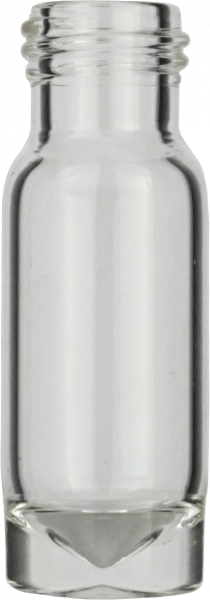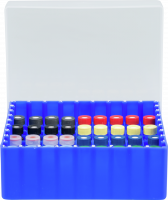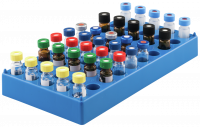Screw neck vial, N 9, 11.6x32.0 mm, 1.1 mL, cone in solid glass bottom, clear

*taxes and shipping not included
Delivery time approx. 5 working days
| Quantity | Price/unit |
|---|---|
| To 9 | $100.10 |
| From 10 | $85.80 |
| From 50 | $78.00 |
Ideal vial for reactions and concentrations; no adapter is required to run it in the autosampler.
| Vial category | Micro-vial |
| Vial type | Screw neck vial |
| Nominal diameter | N 9 |
| Vial material | Clear glass, 1st hydrolytic class glass |
| Vial dimensions | 11.6 mm x 32.0 mm |
| Vial diameter | 11.6 mm |
| Vial height | 32.0 mm |
| Usable volume | 1.1 mL |
| Vial opening | Wide |
| Writing patch | No |
| Silanized | No |
| Additional vial features | 15 µL funnel in solid glass bottom |
| Bottom shape of the vial | Solid flat glass bottom |
| Recommended application(s) | Concentrations, GC, HPLC, Reactions |
| Autosampler compatibility | Agilent, CTC, Dionex, Knauer, Shimadzu, Thermo Scientific, Varian, VWR, Waters |
| Storage temperature | 15–25 °C / 59–77 °F |
| Scope of delivery | 100x N 9 glass screw neck vials |
| Gross weight (incl. packaging) | 312.8 g / 0.69 lbs |
| Packaging dimensions | 93 x 180 x 39 mm / 3.66 x 7.09 x 1.54 Inch |
| Hazardous material | No |
High recovery vials are - from the outside design - standard vials, however, with a solid glass bottom with an inner cone in it. This way they offer a very low residual volume with a high total volume at the same time. In addition they don’t need any adapters to run in an autosampler, as require micro-vials with a conical bottom.
High recovery vials are ideal sample containers for reactions or concentrations, as the solid glass bottom offers excellent heat transfer. In unconcentrated condition the sample has a fairly high volume requiring standard sample volume vials. After the concentration process the needle necessitates optimal conditions for sample removal of the now only small amount of sample. The inner cone in the bottom is ideal for this, as the sample always will flow to the deepest point in the bottom. This way concentration processes do not require sample transfers from large volume vials into smaller micro-vials that may cause sample loss.
High recovery (Microliter) screw neck Vials N 9 for concentrations and reactions
Aside from the above-mentioned special features, also the following general characteristics of screw neck vials N 9 apply:
Glass Material: 1st hydrolytic class glass
This glass material shows an excellent chemical resistance to acidic and neutral solutions. Due to its relatively low alkali content it is even resistant to alkaline solutions.
Volume indications
MN always indicates realistically usable filling volumes at the safe, lower limit
Dimensions
MN always indicates exact dimensions with regard to height and diameter. There might be companies using rounded values (e.g. 11.6 x 32 mm by MN versus 12 x 32 mm)
Screw neck vials N 9 do not have a standardized thread design like other autosampler vials, e.g. 8-425 GPI thread design (US standard) for screw neck vials N 8. This is due to the fact, that the cap height has artificially been reduced, in order to allow the robotic arms of the Agilent autosampler to grab the vial between edge of the screw cap and the shoulder of the vial. The screw cap N 9 was height-wise designed like a traditional crimp cap, leaving the thread end in the middle of the neck. Due to the lack of standardization we strongly recommend to buy vials and caps only out of one source of supply.
Certificate of Conformity (CoC)
Certificates of conformity need to be requested from us indicating part number and Lot. CoCs for vials neither are available on our website nor are they automatically being packed into the box of the vials.
Packaging
The vials are packed with 100 pieces in a corrugated polypropylene box that offers optimal protection for the glass. The bottom part is shrink-wrapped for tamper-evidence. By closing the lid you can avoid contaminations from the lab environment into the vials during consumption. Label with MN REF and lot indication can be found on the front side of the box.
Intended usage
MACHEREY-NAGEL vials are designed and intended for lab usage only. The user has to ensure that the products used are suitable for the intended application. This can be verified by asking for cost-free testing samples from us.
Freezing of vials
Whether or not vials can be used in freezers is a not easy to answer question, since it is also a matter of the vial’s filling level and the expansion coefficient of the sample during freezing. Basically you can freeze a vial, but it should also be noted that temperature fluctuations are limited, i.e. thawing and freezing may have to take place in stages (no sudden thawing, e.g. with strong heat). The vial should withstand -20 °C, provided the filling level and expansion coefficient are within the scope of the vial’s capacity, however, we generally recommend customers to test this, as each sample behaves differently in terms of expansion. Please also consider that due to big temperature differences, screw caps can develop restoring forces, i.e. the cap loosens. Therefore it might be recommendable to use a closure technique for this application, that always achieves the same tightness regardless of the temperature. This is usually the case with crimp neck vials and closures - provided the crimping process was carried out correctly.
High recovery vials are available with
screw neck N 9 and crimp neck N 11. Both varieties are suitable for almost all autosamplers in GC and HPLC, including those with robotic arms (Agilent®).
 Crimp neck vial, N 11, 11.6x32.0 mm, 1.1 mL,conical + round pedestal, clear
Crimp neck vial, N 11, 11.6x32.0 mm, 1.1 mL,conical + round pedestal, clear  Crimp neck vial, N 11, 11.6x32.0 mm, 1.1 mL,conical + round pedestal, amber
Crimp neck vial, N 11, 11.6x32.0 mm, 1.1 mL,conical + round pedestal, amber  Crimp neck vial, N 11, 11.6x32.0 mm, 1.1 mL, cone in solid glass bottom, clear
Crimp neck vial, N 11, 11.6x32.0 mm, 1.1 mL, cone in solid glass bottom, clear  Screw neck vial, N 9, 11.6x32.0 mm, 1.1 mL, conical + round pedestal clear
Screw neck vial, N 9, 11.6x32.0 mm, 1.1 mL, conical + round pedestal clear  Screw closure (bonded), N 9, PP,blue,center hole,Silic. beige/PTFE white, 1.3 mm
Screw closure (bonded), N 9, PP,blue,center hole,Silic. beige/PTFE white, 1.3 mm  Screw closure (bonded), N 9, PP,blue,center hole,Silic. beige/PTFE w.,slit,1.3mm
Screw closure (bonded), N 9, PP,blue,center hole,Silic. beige/PTFE w.,slit,1.3mm  Screw closure, N 9, PP, blue, center hole,PTFE red/Silicone white/PTFE red,1.0mm
Screw closure, N 9, PP, blue, center hole,PTFE red/Silicone white/PTFE red,1.0mm  Screw closure, N 9, PP/steel, magnetic, center hole, Silicone w./PTFE red, 1.0mm
Screw closure, N 9, PP/steel, magnetic, center hole, Silicone w./PTFE red, 1.0mm  Screw closure, N 9, PP, blue, center hole, Silicone white/PTFE red, 1.0 mm
Screw closure, N 9, PP, blue, center hole, Silicone white/PTFE red, 1.0 mm  Screw closure, N 9, PP, blue, center hole, Silicone white/PTFE blue, slit, 1.0mm
Screw closure, N 9, PP, blue, center hole, Silicone white/PTFE blue, slit, 1.0mm  Screw closure, N 9, PP, blue, center hole, Red Rubber/FEP colorless, 1.0 mm
Screw closure, N 9, PP, blue, center hole, Red Rubber/FEP colorless, 1.0 mm  Screw closure, N 9, PP, blue, closed top, Silicone white/PTFE red, 1.0 mm
Screw closure, N 9, PP, blue, closed top, Silicone white/PTFE red, 1.0 mm  Vial container, max. diameter 12 mm, 81 pos., with lid and divider, stackable
Vial container, max. diameter 12 mm, 81 pos., with lid and divider, stackable 


